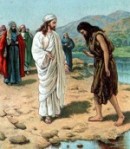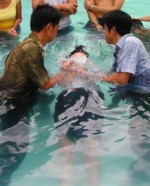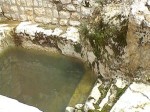In today’s Bible study, I want to teach on the true significance of water baptism in light of Hebraic thought and history, as well as the practice of the early Christian Church.
The Ministry of John the Baptizer
John was called “John the Baptist” – not because he was a member of the Baptist church, nor was he ordained in the Baptist denomination (thank God Christianity wasn’t divided into denominations in those days), but because he practiced water baptism as an outward demonstration of a person’s repentance from sin and committing their lives to God.
John was a direct male descendant of Aaron, brother of Moses. He was a Kohen (or Cohen) the distinct priestly line of Kohenim that were only permitted to minister in the Old Testament Temple. Although John was raised in traditional Judaism and his father Zachariah (also a Kohan) served as a priest in the Jerusalem temple, John chose not to follow his priestly heritage. It was God’s will that John not be contaminated by the corrupt religious system of his day. He was a Nazarite from birth and was filled with the Holy Spirit while still in the womb (Luke 1:15). Instead, he obeyed God’s call to be a prophet to the nation of Israel (The prophet Jeremiah was also a Kohenim and expected to serve as a priest after his father, but later became a prophet in obedience to God’s calling). But, John was not just a prophet; he was distinguished with the great honor of being the forerunner of Jesus Christ the Messiah.
John’s greatness cannot be denied. Every one of the four Gospels begins their account of the ministry of our Lord by recording some of John’s words of introduction. Jesus Himself spoke very highly of John in this manner:
“I tell you the truth, among those born of women, no one has arisen greater than John the Baptist. Yet the one who is least in the kingdom of heaven is greater than he is” – Matthew 11:11.
Water Baptism in the Early Church
The early church was first comprised of all Jewish believers in Jesus (Yeshua in Aramaic-Hebrew). The first apostles and their growing number of disciples were but one of many Jewish sects at that time (such as the Pharisees, Sadducees, Essenes, etc.) In fact, the first disciples of Jesus did not call themselves “Christians” (only years later was this term coined), but simply followers of “The Way” – a shortened version of “the true way” or “the right way” in comparison to traditional Judaism and other religions. These early believers in Jesus continued to worship in the Jerusalem temple and observe the laws of Judaism.
However, these early followers of The Way differed greatly from other Jewish sects in that they believed that Jesus is the Messiah, that He had died for the remission of our sins (as the Holy Lamb of God), and that His resurrection from the dead ushered in a new age of God’s kingdom rule in fulfillment of Old Testament prophecy. Everywhere, they preached in Jesus’ name and water baptized all new converts into The Way. They grew into a community of believers in Jerusalem devoted to practicing Jesus’ teachings, prayer and fellowship.
Water baptism (by full immersion in living water) was not a new concept to Jews. It was actually a common practice in those times. All pious Jews frequently immersed themselves in ritual pools known as “Mikveh’s”* to spiritually purify themselves. So the idea of water purification was not foreign to most Jews when John the Baptist came on the scene. They understood his message of repentance from sin and the corresponding outward act of purification by washing and immersion in a pool of water or river.
The Forerunner of Messiah.
John the Baptizer began his prophetic ministry around A.D. 28. His body was lean and hardened by years of solitary desert life. His hair and beard was long and unkempt, and he dressed in a single garment made of rough camel’s hair bound by a leather belt. He traveled the land preaching a passionate message: “Repent, for the kingdom of heaven is at hand.”
Many responded to John’s call for repentance and spiritual renewal. They would immediately wade out with John into the Jordan River, and he would baptize them as an outward demonstration of death to the old life of sin and resurrection to a new life of righteousness in Christ. Unlike the frequent Jewish Mikveh washings, John’s baptism was a one-time event for a renewed people of God.
John was God’s true prophet who led the way for the beginning of the Christian Church. Although he admitted that he was not the Messiah, the prophet Isaiah had long ago declared him to be the forerunner of Jesus the Messiah: “[John was] the one crying in the wilderness, making straight the way of the Lord, make straight in the wilderness a highway for our God” (Isaiah 40:3)
John the Baptizer’s prophetic message struck conviction of sin and fear of God’s judgment among his hearers, so much so that even the religious Pharisees and Sadducees came to be baptized by him. On one occasion he thundered at these religious leaders, “You brood of snakes! Who warned you to flee from the wrath to come! Bear fruit that befits repentance, and do not presume to say to yourselves, ‘We have Abraham as our father’…” John dispelled their false sense of security: neither their birthright as Jews nor their religious heritage nor their important leadership positions, would save them from God’s wrath to come if they did not open their hearts in true repentance; they were just as spiritually condemned as non-Jews.
Jesus the Messiah was greater than John.
John himself admitted he was not the Messiah, but a humble messenger of God. When questioned about whether he was Elijah, or “The Prophet” (spoken of by Moses in Deuteronomy 18:18-19), he told them “I am not.” “I baptize you with water for repentance, but he [Jesus the Messiah] is coming after me is mightier than I, whose sandals I am not worthy to carry; he will baptize you with the Holy Spirit and with fire” (Luke 3:16).
At the beginning of Jesus’ ministry, He came to the Jordan River to be baptized by John. One day while John was preaching, he saw a figure approaching him and immediately stopped and cried aloud, “This is he of whom I said, ‘After me comes a man who is mightier that I, for he was before me” (John 1:15) When Jesus asked John to baptize Him, he was astonished and said, “I need to be baptized by You!” But Jesus insisted, “Let it be so now, for thus it is fitting for us to fulfill all righteousness” (Matthew 3:13-14).
So John obeyed Jesus and baptized Him (even though Jesus should be the one baptizing John). As soon as Jesus emerged from the water, everyone saw the heavens open up and the Holy Spirit descend upon Jesus “like a dove” (not an actual dove, but the Spirit’s gentle presence), and a voice came from heaven, saying, “You are my beloved Son; with You I am well pleased” (Matthew 3:16).
The Christian Rite of Baptism
John the Baptizer pioneered the rite of water baptism practiced in most Christian churches today. Although certain churches practice a “sprinkling” type of baptism, the correct way has always been by full immersion. The proper manner of baptism as performed by John, the twelve apostles, and the early Christians is the complete dunking method. The penitent sinner should acknowledge his repentance from sin and accept Jesus as his Savior while another believer or minister of God stands beside him or her, and extend God’s forgiveness and acceptance into the Christian family. According to Jesus’ command, the words should be spoken over the new convert, “I now baptize you in the name of the Father, the Son, and the Holy Spirit for the remission of your sins” (Matthew 28:18-19)
When I was a baby I was baptized by a Roman Catholic priest with the sprinkling of water on my forehead. But after I left the Roman Catholic Church and became a Born-Again Christian, I was baptized again. This second time it was by full immersion in a pool of water – just as Jesus and His disciples did.
If you have accepted Jesus the Messiah as your Savior and Lord and have never been water baptized (by full immersion), it’s time that you did so. You can be water baptized in a church baptismal, a swimming pool, a river, or even a spa – as long as you do it prayerfully with a repented heart towards God. Make sure you are able to go completely under the water; that’s how true believers have done it from the very beginning of the Christian church.
If water baptism was important to Jesus, it should be important to us. Don’t keep putting it off. I know God will bless you in a special way for honoring His Word.
– Luis Josephus

www.4JesusOutreach.com
EMAIL US




